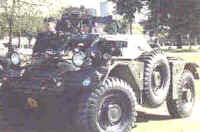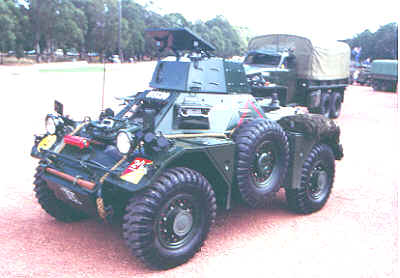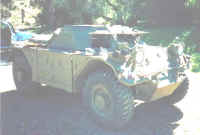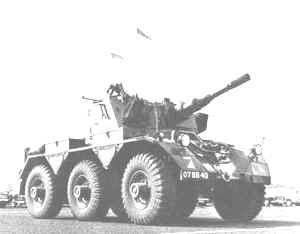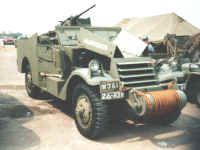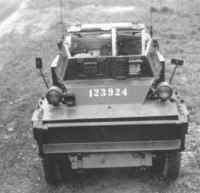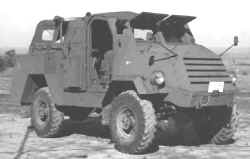 |
|
|||
|
|
||||
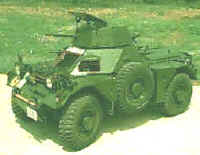
Ferret |
Ferret |
Page index |
Ferret Scout Car
The Ferret Scout Car was of British origin and, in 1960, replaced the Centurion tank in the 4th/19th Prince of Wales Light Horse. The Ferret was armed with a .30 cal Browning machine gun, a six cylinder Rolls Royce petrol motor, weighed 3.75 tons, could reach speeds of 60 mph and had a crew of two. This introduction of new equipment also signalled a shift in the role of the 4th/19th Prince of Wales Light Horse to reconnaissance. The Ferret proved to be an ideal vehicle to undertake this role, having a low profile and being a quiet vehicle. The later generation of the Ferret Scout Car had some modifications, including a turret.
Staghound Armoured Car
|
| The
Staghound Armoured Car was of American origin and, together with
the Ferret Scout Car, replaced the Centurion tank in the 4th/19th
Prince of Wales Light Horse. It was armed with a 37mm gun, a GMC
Chevrolet twin six cylinder petrol motor, weighed 12 tons, could
reach speeds of 55 mph and had a crew of five.
It offered the 4th/19th Prince
of Wales Light Horse, which had just taken on the reconnaissance
role, a vehicle capable of conducting effective reconnaissance,
but at the same time able to extricate itself from trouble if
required. |
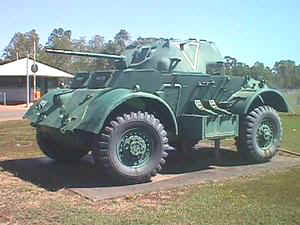 |
Saladin 
Saracen 
| The
Saracen Armoured Personnel Carrier was introduced into the 4th/19th
Prince of Wales Light Horse at the same time as the Saladin Armoured
Car, from 1965 – 1966.
It provided the unit with the ability to move personnel (such as Assault Troopers) within an armoured vehicle and signalled a change in role towards transporting personnel around the battlefield. |
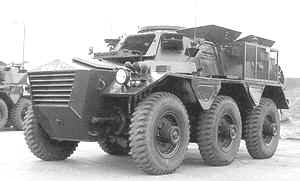 |
It weighed 10 tons and could reach a top speed of 70km/h. It had a crew of two, could carry 10 personnel and was armed with a .30 cal machine gun. It complemented the capability of the sabre troops, which were equipped with two Ferret Scout Cars, two Saladin Armoured Cars and a Saracen Armoured Personnel Carrier.
M113A1 Armoured Personnel Carrier
and family 
 An
M113 operating in Viet Nam (Also see The Tracks)
An
M113 operating in Viet Nam (Also see The Tracks)
Performance trials held in
1962 – 63 resulted in the adoption of the US family of light armoured
vehicles and gave the Army its first modern armoured and tracked vehicle
for ten years. The M113 had a GMC two stroke diesel engine, weighed 11
tons, was amphibious and could reach speeds of 40 mph. The M113 was
designed to carry ten riflemen with their equipment in addition to the
crew of two and gave protection against small arms fire. The original
model carried a .50 cal machine gun on a pintle mount, which lacked
protection for the commander when firing. The Armoured Personnel Carriers
(APCs) taken to Vietnam had a bullet proof shield fitted which gave some
protection. The danger resulting from mortar fire prompted turrets to be
fitted. A number of American M74C turrets were ordered and introduced into
service during the second half of 1966. A further improvement, the T50
turret, which was also American, eventually became the standard turret
during the period 1967 – 68. The T50 turret was a basic design and
mounted either one .50 cal and one .30 cal machine gun or twin .30 cal
machine guns, with the twin .30 cal machine gun being the initial standard
fit. The most prized characteristic of the M113 was its mobility over
various types of ground. The family of vehicles included the personnel
carrier, mortar carrier, command vehicle, fitters vehicle, recovery
vehicle and ambulance, all of which were employed in the 2nd Cavalry
Regiment. ![]()
FSV/MRV 
| During the
period that the Regiment was equipped with the M113, further unique
Australian variants were developed and introduced. The loss of
firepower in a troop following the withdrawal of the Saladin
Armoured Car was overcome by the development of the Fire Support
Vehicle (FSV).
The FSV was an interim vehicle which was a combination of the M113 hull with a Saladin turret. The FSV had a 76mm main armament, a .30 cal coaxial machine gun and a .30 cal machine gun. There was power assisted traverse, the commander had no sight and night fighting was achieved by firing on fixed lines or with active illumination. |
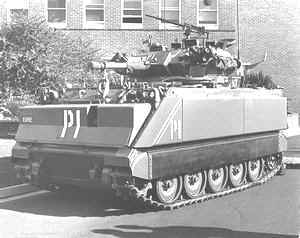 |
The Medium Reconnaissance
Vehicle (MRV) see photo
replaced the FSV after the Army took delivery of 36 Scorpion
turrets in 1977. The MRV was also an interim vehicle, which had a Scorpion
turret fitted to an M113 hull. The MRV had a 76mm main armament, two .30
cal machine guns and an early image intensification night sight. The MRV
was also fitted with flotation pods to make it amphibious. By 1978 the MRV
had completely replaced the FSV in the Regiment.
![]()
